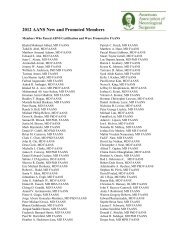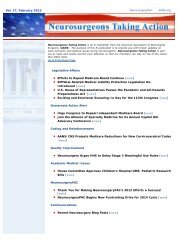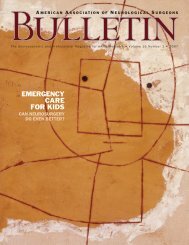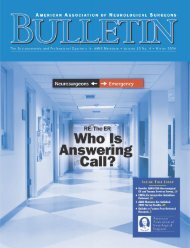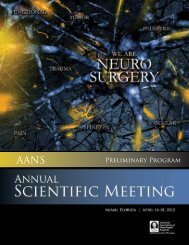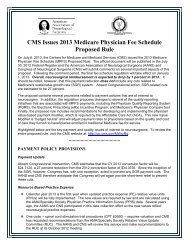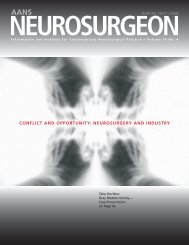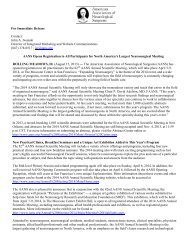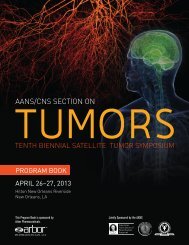view PDF - American Association of Neurological Surgeons
view PDF - American Association of Neurological Surgeons
view PDF - American Association of Neurological Surgeons
Create successful ePaper yourself
Turn your PDF publications into a flip-book with our unique Google optimized e-Paper software.
COMPLETING THE PICTURE<br />
Compensation<br />
2006 2004<br />
Receive a Stipend 50% 33%<br />
More than $3,000 per diem 3% 2%<br />
$2,001–$3,000 per diem 7% 6%<br />
$1,501–$2,000 per diem 7% 8%<br />
$1,001–$1,500 per diem 17% 25%<br />
$751–$1,000 per diem 19% 17%<br />
$501–$750 per diem 7% 11%<br />
$500 or less per diem 13% 17%<br />
Not paid per diem; have another 26%* 16%<br />
compensation arrangement<br />
*Some respondents commented that they included their arrangements <strong>of</strong><br />
employment (such as “employed by hospital”) and salary (such as “part <strong>of</strong><br />
salary package”) in their responses. Percentages are rounded.<br />
Sources: 2006 Data, AANS 2006 Workforce Survey; 2004 Data,<br />
2004 AANS/CNS Neurosurgical Emergency and Trauma Services Survey<br />
Figure 2. Compensation for Neurosurgical On-Call Services<br />
Services Covered<br />
Cover all services 61%<br />
Cranial 48%<br />
Spinal 47%<br />
Trauma 46%<br />
Pediatric 22%<br />
Other 3%<br />
0 10 20 30 40 50 60 70 80<br />
PERCENT<br />
Percentages are rounded. Participants could select more than one response.<br />
Source: AANS 2006 Workforce Survey.<br />
Figure 3. Services Covered by On-Call Neurosurgeons<br />
.<br />
FACILITY TYPE<br />
. Academic Medical Center 38%<br />
.<br />
Community Hospital 59%<br />
Other 6%<br />
. .<br />
.<br />
.<br />
.<br />
AGE DISTRIBUTION<br />
35 or Younger 6%<br />
36–45 37%<br />
46–55 36%<br />
56–65 20%<br />
66 or Older 2%<br />
. .<br />
.<br />
.<br />
TRAUMA CENTER DESIGNATION<br />
Level 1 Trauma Center 40%<br />
Level 2 Trauma Center 37%<br />
Level 3 Trauma Center 10%<br />
Other 18%<br />
.<br />
.<br />
.<br />
.<br />
.<br />
YEAR NEUROSURGEONS EXPECT TO<br />
STOP TAKING EMERGENCY CALL<br />
2010 or Sooner* 22%<br />
2011–2015 18%<br />
2016–2020 19%<br />
2021 or Later 19%<br />
Don't Know* 22%<br />
Figure 4. Where On-Call Neurosurgeons Are Practicing<br />
Percentages are rounded. Participants could select more than one<br />
response. Source: AANS 2006 Workforce Survey.<br />
Of the scant six percent <strong>of</strong> neurosurgeons who did not take<br />
emergency call, 48 percent selected as their reason “other,” and the<br />
great majority <strong>of</strong> these respondents specified age-related exemptions<br />
such as recent retirement or senior partner status. Other reasons this<br />
group reported for not taking call included insufficient pay for<br />
emergency services (17 percent), disruption <strong>of</strong> routine practice<br />
schedule (15 percent), lifestyle interference (13 percent), malpractice<br />
insurer’s premium discount for eliminating trauma or other emergency<br />
services (6 percent), and malpractice insurer’s discontinuance<br />
<strong>of</strong> coverage for emergency services (2 percent).<br />
Figure 5. Age Distribution and Year Expected to Stop Taking Call<br />
*Responses <strong>of</strong> those not currently taking call may have been included. Percentages<br />
are rounded. Source: AANS 2006 Workforce Survey.<br />
For neurosurgeons who said they were planning to stop taking<br />
call, the most influential factor was retirement; the great majority <strong>of</strong><br />
those planning to retire said they had intended to do so anyway, but<br />
other factors reported were excessive on-call demands and high malpractice<br />
insurance premiums. The second-ranked factor for those<br />
planning to discontinue call was lifestyle interference, followed by<br />
insufficient pay for emergency services, disruption <strong>of</strong> routine practice<br />
schedule, and “other”unspecified factors. All <strong>of</strong> these factors outranked<br />
the insurer’s elimination <strong>of</strong> malpractice insurance coverage<br />
for call services or insurance premium reduction in return for elim-<br />
10 Vol. 15, No. 2 • 2006 • AANS Bulletin



